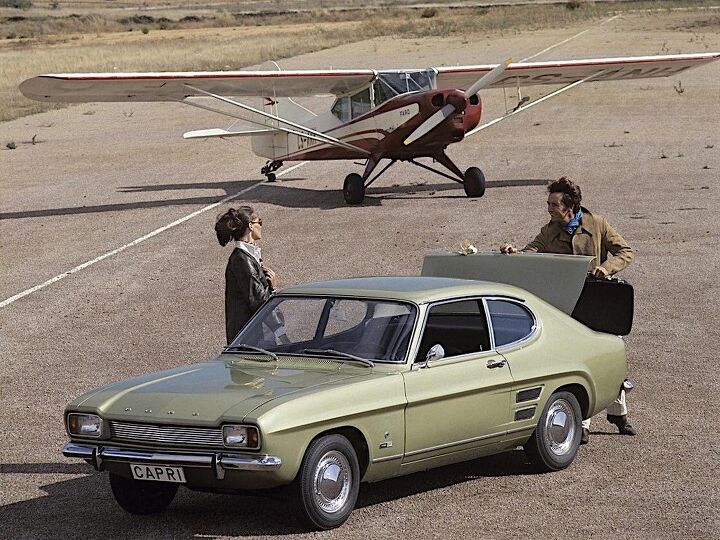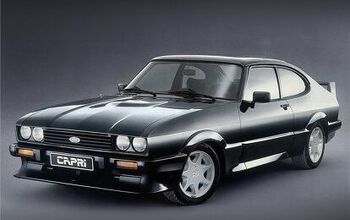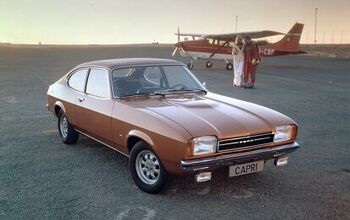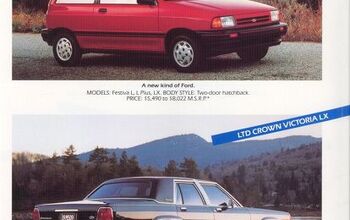Rare Rides Icons: The Ford Capri, a European Mustang (Part I)

Across two generations and nearly two decades of production, the Ford Capri existed as the European market alternative to the very America-centric Mustang. Basic or more luxurious, thrifty or more powerful, Capri played an important role in its day: It brought a practical, fun driving experience within reach of the average European family consumer.
The European Capri began its development when the Mustang was about to be unleashed on America, in 1964. And much in the way the Mustang shared its platform with the midsize Falcon sedan, the Capri shared its bones with the midsize Mark II version of the Cortina. While the Cortina was available with two or four doors as a sedan or an estate, the Capri was limited in its scope to a two-door fastback.
Capri’s sporty design was penned by Phillip T. Clark (1935-1968), who’d also drawn up the original Mustang, designed its emblem, and suggested its name to Lee Iacocca. Given Ford’s intent to recreate the idea of a pony car for the European market, Clark was the ideal candidate for the job. Unfortunately, Capri ended up as Clark’s final work; he passed away due to kidney failure before his design entered production.
Ford selected the Capri name for two reasons: First, it was exotic to use the name of an Italian island, and second, Ford already owned the Capri trademark. Previously, Capri was used on a coupe version of the unpopular Ford Consul Classic. The intended name for the new car was Colt, but Ford found that Mitsubishi already owned that particular trademark.
The first Capris were built in November 1968 at Ford’s Halewood plant in England. Production expanded shortly thereafter to West Germany, at the plant in Cologne. Other eventual production locations for the first generation Capri included Saarlouis (also in Germany), Genk in Belgium, Port Elizabeth in South Africa, and at Homebush, Australia. The exciting new coupe had its debut in January 1969 at the Brussels Motor Show in Belgium, and Capri went on sale as a 1969 model.
Aside from its sleek body, the Capri was very similar to the Cortina upon which it was based. Its suspension was the same MacPherson setup at the front, and live axle with leaf springs at the rear. Steering was sourced from the smaller Escort. Capri used a total of 13 different engines dependent upon trim, market, and production year. Engines had four, six, or (rarely) eight cylinders. Four-pot power was inline or V configuration, with 1.3-, 1.6-, and 2.0-liter inline fours, alongside 1.3-, 1.5- and 1.7-liter V4 engines from Ford’s Taunus lineup. V6 power was 2.0-, 2.3- 2.6, 3.0-, or 3.1-liters, From the Cologne or Essex engine families. There was a singular V8, the familiar 5.0-liter Windsor, but that was offered only in South Africa and only on 500 cars. All first-gen Capris were four-speed manuals.
Of note, initial Capris for the UK market were built in England and used the inline-four engines, while V4 versions were sold in the rest of Continental Europe and built in Germany. Trims and market offerings expanded quickly, as the positive reviews of the Capri arrived right away. Capri was on sale in Australia by mid-1969, and in spring of 1970 it arrived in South Africa and North America, though in the latter market it had some badge engineering applied.
A captive import like the Merkurs of the future, the Capri used for North American purposes was marketed as “imported by Lincoln-Mercury.” All examples hailed from the Cologne factory in West Germany, as it already produced cars in left-hand drive. Lincoln-Mercury dealers displayed the small, zesty Capri next to the enormous Marquis, Montego, and Colony Park. However, it was seemingly advertised separate to the other, not-so-foreign Mercury cars. Worth noting, the Capri just said “CAPRI” on it, and did not wear any Mercury badging. Unlike European Capris, an automatic transmission was optional.
Visually differentiated to European market Capris, North American ones wore four sealed beam headlamps as composite European lamps were not compliant with archaic US headlamp regulation. That meant turn signal indicators moved into the grille. The quad headlamp look was available in Europe, but was reserved for the sportiest Capri models there, the GT and RS. All North American Capris used the power dome style hood, not present on all trims elsewhere. The Capri was a discount offering at Mercury, and asked $2,300 in spring 1970 ($16,500 adj.). Sold as an economic sports car, Capri didn’t offer upscale options and engines like in other markets. Though Mercury’s version of the Capri used British-built Kent inline-four engines initially, power was quickly adapted for 1971 to align more closely with the Pinto. After the Pinto’s introduction in ’71, some Pinto engines did make it to Capris in other markets outside North America. Domestically there were inline-four engines of 1.6 (Kent, 1970 only), 2.0, or 2.3 liters, or a 2.6- or 2.8-liter V6. V6 engines were from the Cologne family, and marked the first time Ford offered a V6 engine in the North American market. 1973 brought with it ugly five mile-per-hour bumpers, as the original slimmer chromed bumpers were replaced by plastic.
Elsewhere in the world the Capri continued in its popularity, and was entered in races from time to time. A modified Capri was used in the European Touring Car Championship in 1971 and 1972. By 1972 the Capri had proven itself quite market-worthy, and Ford granted it a visual update. Tail lamps were larger and no longer the same as the Escort, there were larger headlamps, and a new suspension setup tuned for more comfort. All the Kent inline-fours were all replaced by Pinto inline-fours, but V4 engines remained in production. The changes carried over to the North American Capri, and coincided with the debut of the big bumpers.
1973 was a banner year for Capri, as the coupe netted its highest-ever sales, 233,000. In the UK there was great excitement around a new right-hand drive RS version, as the RS 2600 (Cologne) was replaced by the RS 3100 (Essex) in 1974. RS 3100 was a homologation special, and just 250 were made so Ford could take Capri touring car racing that year. The special version was complete with wider front fenders, Bilstein shocks all around, revised leaf springs, larger disc brakes, and a lower ride height among other edits.
Capri earned its reputation as an affordable, reliable car for enthusiasts and thrifty drivers alike. 1974 was the final year for the first-generation car, and a total of 1.2 million examples were sold globally. Ford was ready to move with the times, and in 1975 introduced a new Capri with a slightly different focus than its predecessor. More in Part II.
[Images: Ford]

Interested in lots of cars and their various historical contexts. Started writing articles for TTAC in late 2016, when my first posts were QOTDs. From there I started a few new series like Rare Rides, Buy/Drive/Burn, Abandoned History, and most recently Rare Rides Icons. Operating from a home base in Cincinnati, Ohio, a relative auto journalist dead zone. Many of my articles are prompted by something I'll see on social media that sparks my interest and causes me to research. Finding articles and information from the early days of the internet and beyond that covers the little details lost to time: trim packages, color and wheel choices, interior fabrics. Beyond those, I'm fascinated by automotive industry experiments, both failures and successes. Lately I've taken an interest in AI, and generating "what if" type images for car models long dead. Reincarnating a modern Toyota Paseo, Lincoln Mark IX, or Isuzu Trooper through a text prompt is fun. Fun to post them on Twitter too, and watch people overreact. To that end, the social media I use most is Twitter, @CoreyLewis86. I also contribute pieces for Forbes Wheels and Forbes Home.
More by Corey Lewis
Latest Car Reviews
Read moreLatest Product Reviews
Read moreRecent Comments
- Carson D Just don't be the whistleblower who reports on the falsification of safety data. That's a deadly profession.
- Carson D I'd have responded sooner, but my computer locked up and I had to reboot it.
- Todd In Canada Mazda has a 3 year bumper to bumper & 5 year unlimited mileage drivetrain warranty. Mazdas are a DIY dream of high school auto mechanics 101 easy to work on reliable simplicity. IMO the Mazda is way better looking.
- Tane94 Blue Mini, love Minis because it's total custom ordering and the S has the BMW turbo engine.
- AZFelix What could possibly go wrong with putting your life in the robotic hands of precision crafted and expertly programmed machinery?







































Comments
Join the conversation
I had the '74 2.0 model with the plastic bumpers. I liked the look of that year. I bought it at one of those "wholesale" places, whatever that was after a long fruitless search for the perfect Celica. The car hunting had tired me out so when I saw it I grabbed it. I thought it was a better choice than the Mustang II.
One small correction: The brochure picture shows the 1973 American-market bumpers, still the same small chrome ones (but with impact absorbers) as earlier models. The 1974 model year brought the plastic "ugly five mile-per-hour" color-keyed bumpers to which I think you refer.